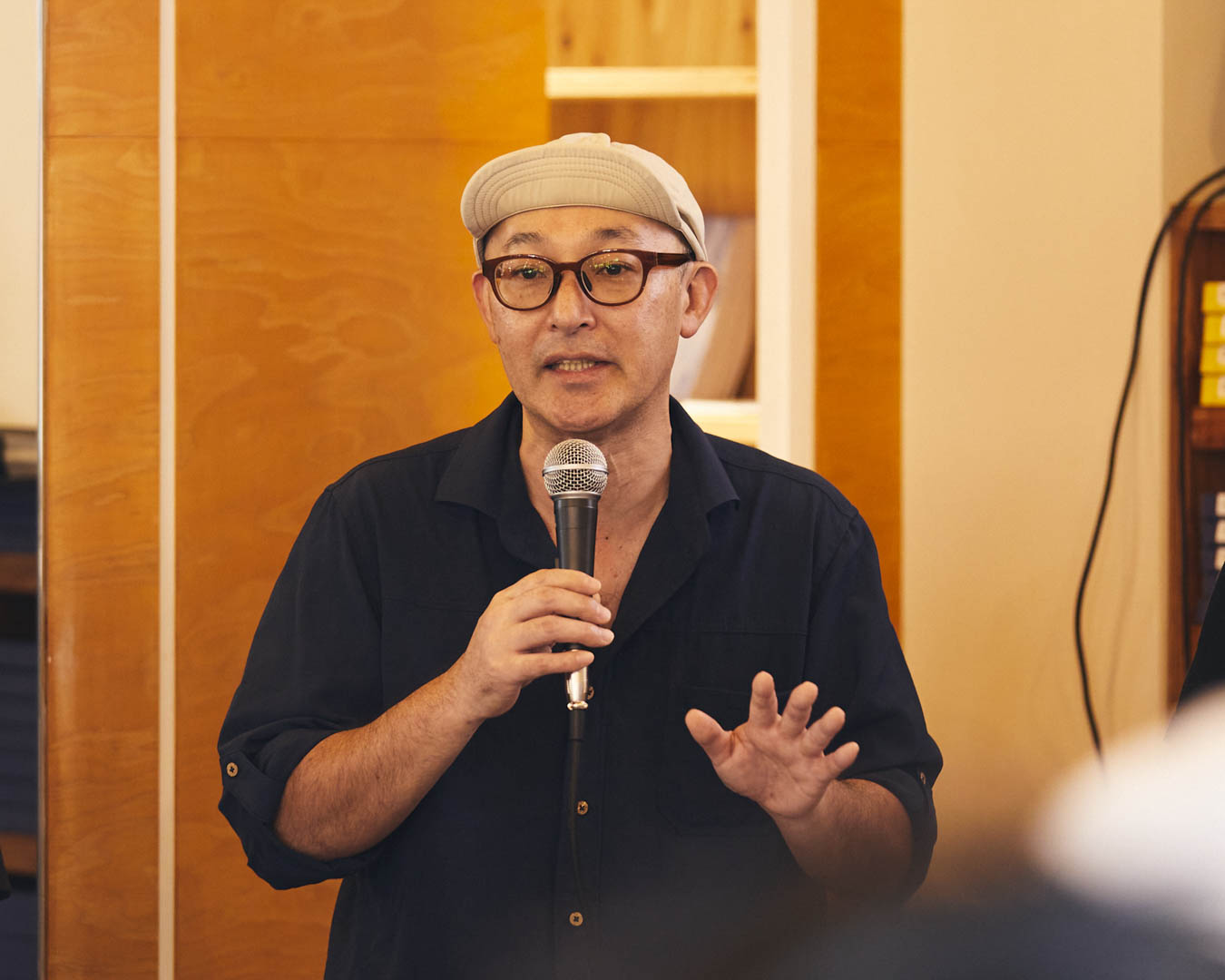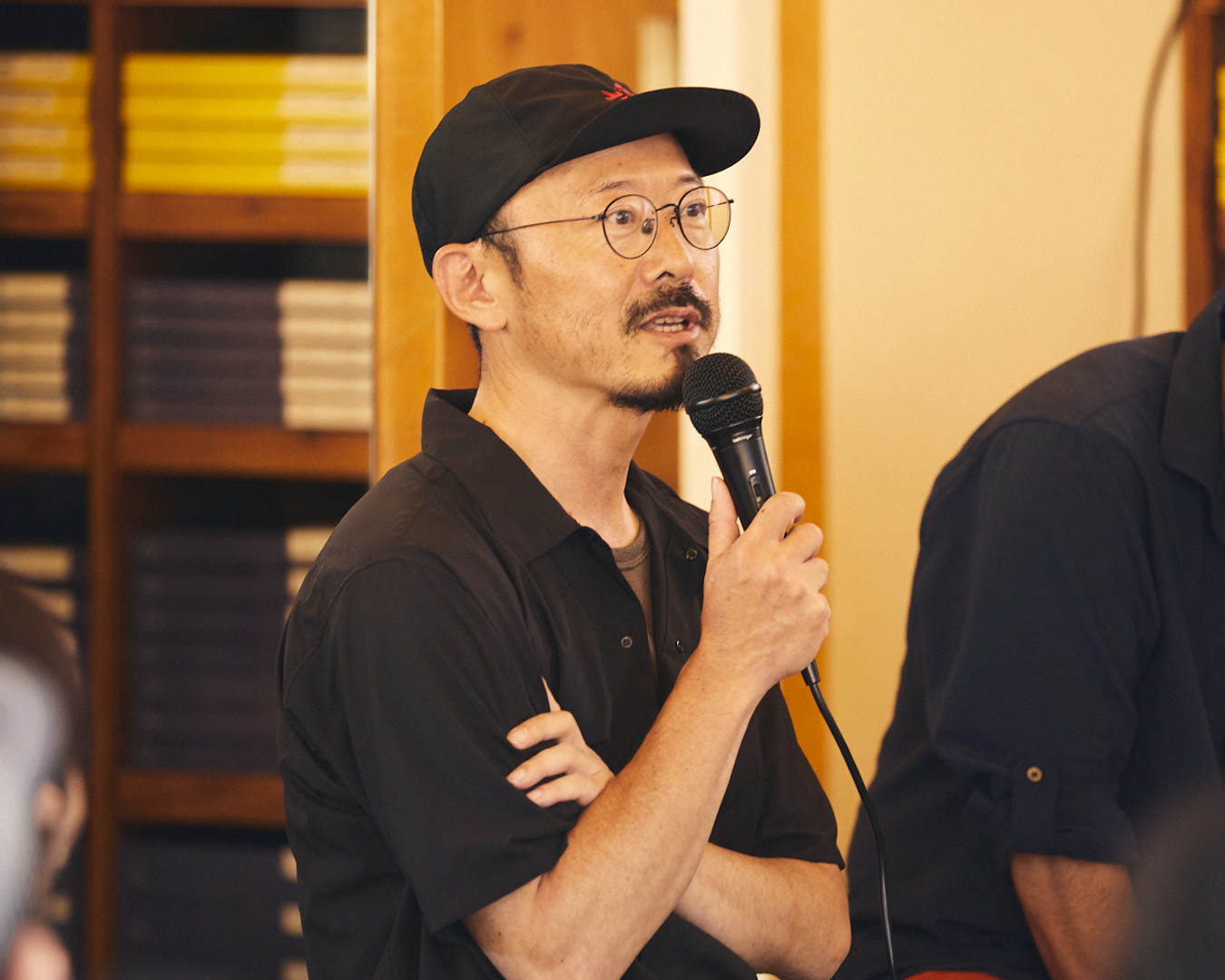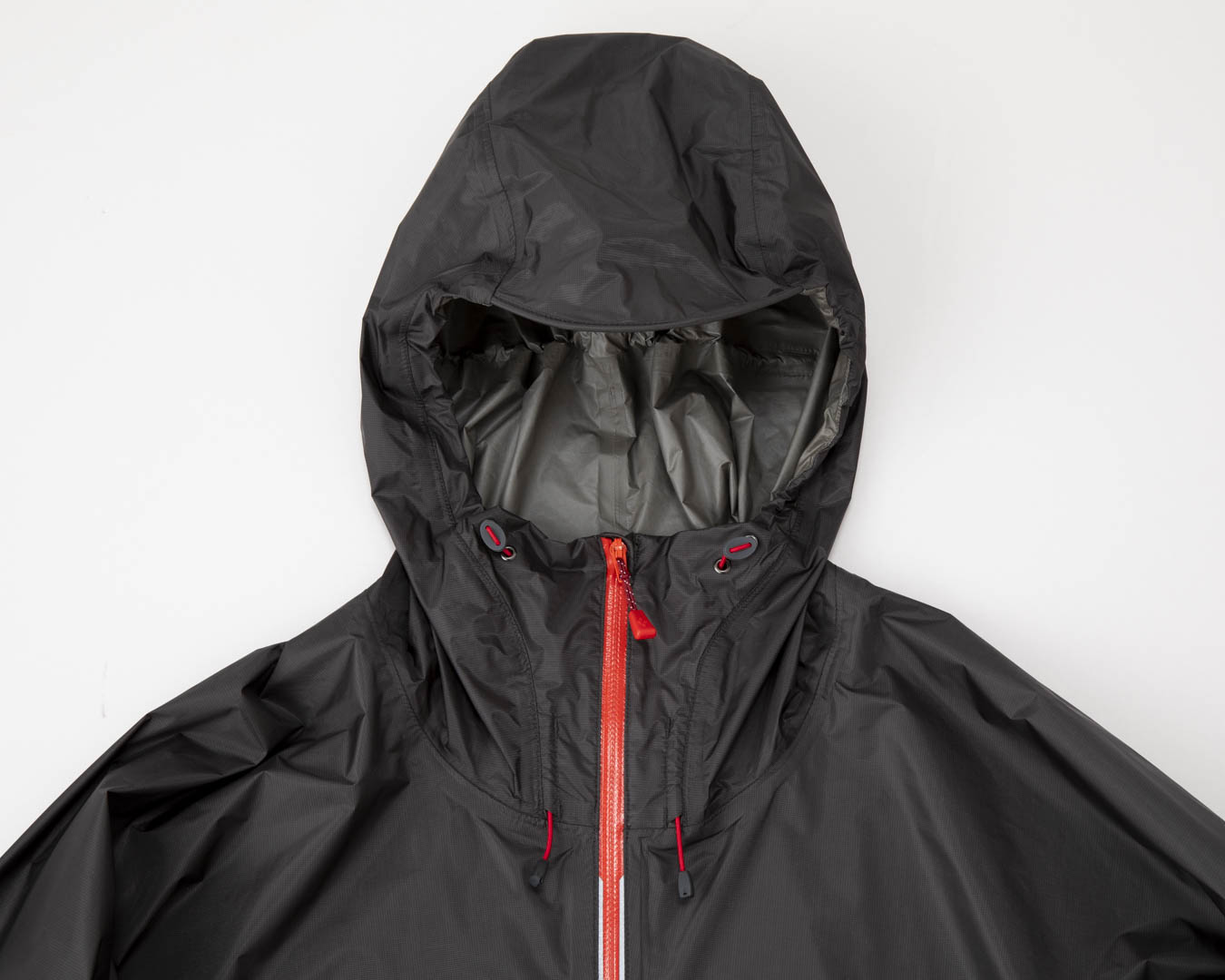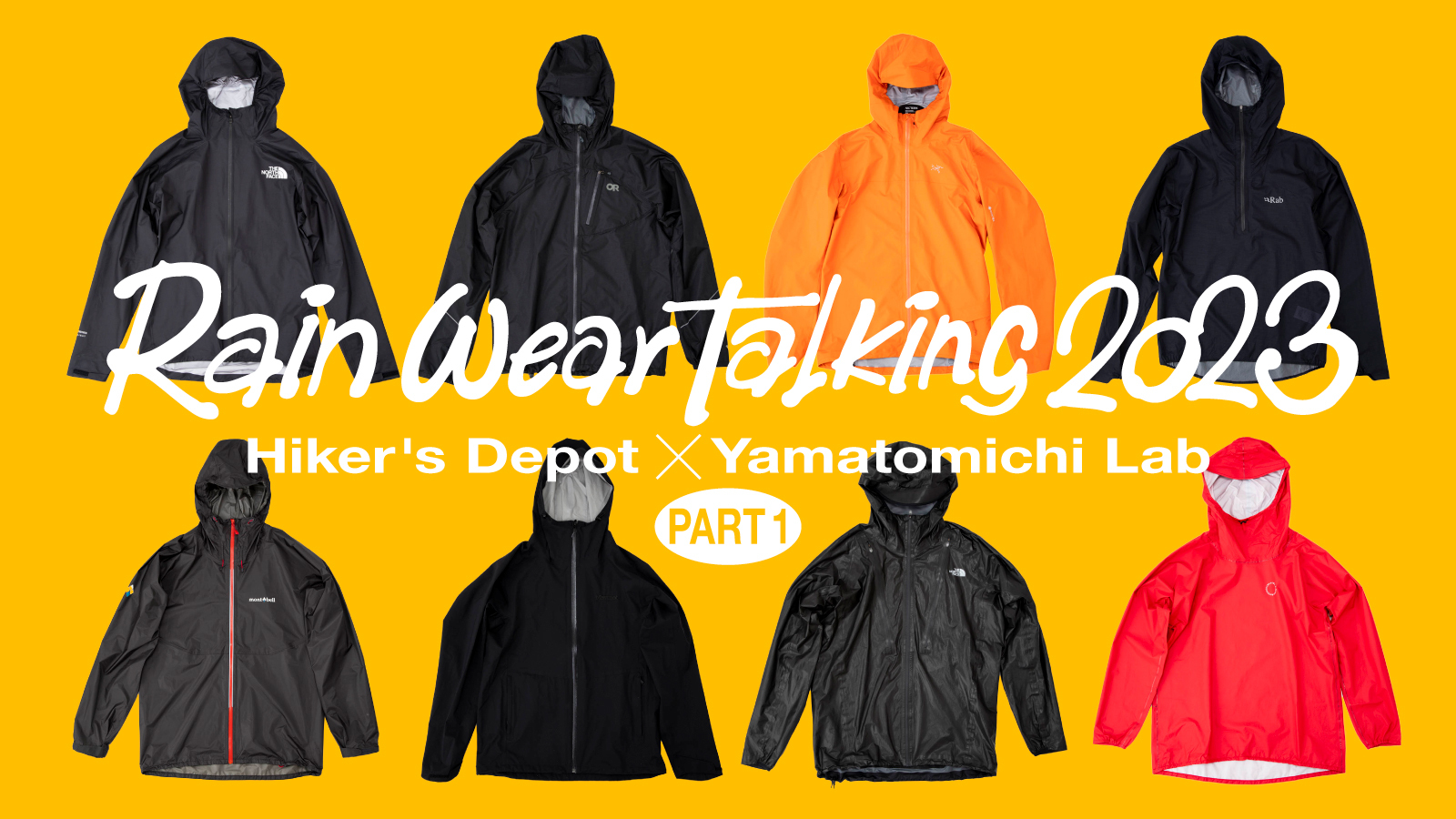Hiker’s Depot × Yamatomichi Lab – Part 1
Photos (people): Hikaru Otake
Hiker’s Depot × Yamatomichi Lab – Part 1
Photos (people): Hikaru Otake
In this program, we invited a familiar face, Tomoyoshi Tsuchiya from Hiker’s Depot. Yamatomichi and Tomoyoshi discusses eight popular products in the current lightweight rainwear market, offering insights into the current state of rainwear by examining them firsthand.
We go in-depth by comparing different materials and garments, starting with the Arc’teryx Novan Shell Jacket, breaking the 200g barrier with Gore-Tex, Rab’s Phantom Pull-On (the world’s lightest rainwear), Outdoor Research’s Helium Rain Jacket (now a classic in lightweight rainwear), and Montbell’s Versalite Jacket, a popular lightweight Japan rainwear.
We hope you enjoy this in-depth geeked out rainwear review between Hiker’s depot and Yamatomichi.
Introduction
Masaaki: The first time was when we launched our UL Rain Hoody, for around 2019, and in 2021 when the UL All-weather series came out. Kei Kuwahara from “Run boys! Run girls!” was also part of that. Now, after two years, I wanted to have another opportunity to talk to Mr. Tsuchiya about rainwear. So, I thought we might as well do it publicly, which is why we came to this event. I will be the moderator for today; I am Mita from Yamatomichi JOURNALS. We are here today with “Hikers Depot” Tomoyoshi Tsuchiya, our founding father Akira and Yamatomichi Lab’s Takahiro, to discuss rainwear.

From left: Akira Natsume, Tomoyoshi Tsuchiya, Takahiro Watanabe, Masaaki Mita
Masaaki: We have selected eight lightweight rainwear products, and we will discuss them while looking at the actual products. However, the purpose of this discussion is not to review and rate these products. The rainwear was some of Yamatomichi’s research stock and we also asked Tomoyoshi to pick out some notable items. We have gathered products that represent each category among the various rainwear with different personalities and features, and we hope to shed light on how far tech has come with rainwear.
Audience “Claps”
1. Arc'teryx - Norvan Shell Jacket
Arc'teryx Lightest Rain Jacket Using Gore-Tex

Weight: 190g
Material: Gore-Tex 3L C-KNIT
Features: Hydrophobic porous film + hydrophilic coating
Structure: 3-layer
Surface:13 denier
Water resistance: 20,000mm
Breathability: 20,000g/㎡/24h
Masaaki: First, we have Arc’teryx’s NORVAN Shell Jacket. This uses Gore-Tex C-KNIT. Gore-Tex is made of PTFE, which is also used for Teflon coating on frying pans. As a lot of you may know, it consists of a membrane with holes that are smaller than water but larger than vapor, sandwiched between the outer and inner layer.
Takahiro: Gore-Tex made the first waterproof breathable material. In principle, they stretched Teflon resin, which creates small holes and they stretch it just enough to allow vapor to seep through. However, if these holes get clogged with dirt or sebum, the breathability is compromised. So, Gore-Tex actually has a coating to prevent this on the skin side. But because of the coating, it slightly reduces breathability.

Masaaki: When we first started researching waterproof breathable membranes at Yamatomichi, we couldn’t understand why Gore-Tex was deliberately coating to reduce breathability. But when we made rainwear using Pertex Shield Pro, which has the same material structure as Gore-Tex but without coating to increase breathability, we faced the problem. So, it was only then that we understood the reason for the coating.
Akira: But thanks to that coating, Gore-Tex is a bit less breathable but warm. This ties into the discussion about the importance of insulation that we mentioned earlier, and I think Gore-Tex is a well-balanced material in many ways.
Masaaki: Gore-Tex comes in various types, but C-KNIT is the main material of current Gore-Tex, which is used in Montbell’s Storm Cruiser, one of the most popular Japan made rainwear. It has a knitted inner lining, and the selling point is its comfortable feel and fit.
Tomoyoshi: Rainwear performance and properties not only depend on the membrane technology but also on factors like the thickness of the outer fabric and the type of inner lining. C-KNIT is nice and thick, sewed kind of like a wool sweater is. It has more stretch thanks to this structure of the lining fabric making it more breathable.

Tomoyoshi Tsuchiya . Hiker’s Depot

Akira Natsume, Founder of Yamatomichi

Takahiro Watanabe, Yamatomichi Laboratory
Takahiro: In addition, the C-KNIT used in this product has a fabric weight of about 85g per square meter. In contrast our newest fabric is 58g per square meter. I think there aren’t many Gore-Tex 3-layer materials as light as this. The jacket’s weight is below 200g.
Masaaki: It’s not easy to get under 200g with Gore-Tex. Arc’teryx positions this as a lightweight jacket for trail running rather than mountaineering. The design and finish are of high quality, as you would expect from Arc’teryx. The sewing and pattern work are remarkable, making it feel truly premium.

When flipped inside out, we can see the beautiful craftsmanship of the pattern and seams. The seams are complex in design, using a variety of thicknesses. The hood is equipped with RECCO reflectors, a distress rescue system that helps for rescuing avalanche victims.

The surface of C-KNIT. If you look closely, you can see that the fibers are knit together.
Tomoyoshi: When customers ask us for lightweight rain gear, we often refer to Montbell’s Storm Cruiser jacket as a standard, which is usually around 250g. So, the standard for lightweight rain gear is between 200g and 250g. Lately, it has settled around 200g. So, 190g is not extremely lightweight, but it offers a balanced fabric thickness that provides some reassurance. Also, I didn’t know until Akira mentioned it earlier, but did you know that the thickness of the outer fabric affects water repellency?
Akira: Water repellency is crucial, and when it doesn’t work, a water film forms on the surface of the rainwear instead of beads, making it less breathable and causing moisture build up inside the garment. Water repellency can be maintained by applying a water repellent coating to the fabric, and the thicker the outer fabric, the better the adhesion of the water repellent agent. However, as the fabric gets thinner for weight reduction, water repellency tends to weaken. So, having some fabric thickness is essential for good water repellency and balanced insulation.
Tomoyoshi: That’s right. So I think it’s fair to say that this jacket has “the right balance” in terms of technology and specs.

The hood has only one adjuster at the back of the head to reduce weight.

The cuffs also have no adjuster to reduce weight.
Akira: However, there is a movement to ban fluorocarbons in Europe, so Gore-Tex’s materials will change in the future. The use of fluorocarbons will also be banned in California, USA, so Gore-Tex, as it is now, might become something that you can’t obtain anymore.
Tomoyoshi: The material will change from fluorocarbon resin to polyethylene. As a result, the fundamental technology of the material will change. It’s said that it will become thinner, but there are concerns about its oil resistance and durability. A change worth noting and to watch out for how the materials are going to evolve in the future for rain gear.

A pocket on the left side that won’t convert to a stuff sack.
Masaaki: The European and American markets are moving towards environmental compliance, and products need to meet these standards to compete.
Akira: Water repellent agents are also increasingly becoming less effective due to environmental concerns. For instance, if we talk about it now, there’s a substance called C0, which doesn’t use fluorocarbons, and it’s gaining popularity for water repellent treatment. But the problem is that it becomes ineffective once it comes into contact with oil. Even though technology seems to be always advancing, but in some cases, functionalities are actually going down hill.
Tomoyoshi: A few years ago, The North Face and Patagonia, for example, eliminated fluorocarbon-based water repellents all at once. But as a result, there was user backlash, complaining about the water penetration. So, they reintroduced it. But societal views pushed technology to move toward environmental compliance, and we are now shifting towards environmental advancements.
2. Rab - Phantom Pull-on
World's lightest Rainwear

Weight: 89g
Material: Pertex Shield
Features: Hydrophilic non-porous membrane
Structure: 2.5-layer
Surface: 7 denier
Water resistance: 20,000mm
Breathability: 20,000g/㎡/24h
Masaaki: Next up is the Phantom Pull-On from Rab. This has been on our radar for a long time. It weighs just 89g, making it the world’s lightest model. It features Pertex Shield, a waterproof breathable material, a 2.5-layer design for weight reduction, and an ultra-thin 7-denier outer fabric.

The fabric is so thin you can see the wash tag through the jacket.

The inside doesn’t have a lining fabric covering the membrane, but has a three-dimensional print to make it more comfortable against the skin.
Takahiro: Pertex Shield, unlike Gore-Tex, doesn’t have holes in its membrane. Instead, it works by absorbing moisture into the membrane and then allowing it to evaporate to the outside, providing breathability. Therefore, it becomes breathable after some moisture build-up.
Masaaki: It’s like a towel that absorbs sweat very quick, and dries out. In simple terms, that’s the principle behind it.
Takahiro: So, on paper, it has high breathability, but in terms of how it feels, it’s a material that can make you feel very wet and sweaty.

Masaaki: There are testing methods defined by JIS for measuring breathability, but they don’t quite align with the how we feel in the field. But there’s no other guideline for measuring breathability, so material manufacturers develop materials that produce good numbers in those tests. So, in reality, they don’t put much thought into how these materials are actually used and felt in the field.
Akira: Can we try putting it in the included stuff sack?
Masaaki: This stuff sack is compact, but it has a wide opening, making it easy to put the jacket inside. It doesn’t cinch tightly, leaving some space at the entrance, but that’s okay. Many Japanese outdoor products have really small stuff sacks, which can be hard to pack.

A very easy to store stuff sack that is super compact!
Akira: Wow, fits right in your pocket.
Tomoyoshi: A great advantage for shoplifters! “laughts”
Akira: Tomoyoshi, you tried the Phantom Pull-On, right?
Tomoyoshi:Yeah, the outer fabric is 7 deniers, but it’s made of a hydrophilic non-porous membrane. Therefore, you will get wet from the inside with sweat. Therefore, as long as you keep moving, it provides decent insulation. However, its biggest weakness is that when you stop and the wind blows, it’s so thin that you can feel the outside temperature directly on your skin. For instance, say your walking in the Japan Alps in autumn, enduring constant rain and wind, with no shelter in sight. However, you must keep moving. In moments when your energy dwindles, it can become a dangerous situation.
Masaaki: It has great specs on paper but when you actually hold it, you may start to doubt that it can withstand rain and wind because of how thin it is. If you choose this based solely on wanting the lightest option, you might regret that decision with your life out on the field.
Tomoyoshi: This is truly a niche product in terms of its usage. It works well for trail running, day hikes when you want to minimize your gear, or for races like the OMM.
Takahiro: In many trail running races, rainwear is a mandatory item and some garments are designed to meet that bare minimum rule, focusing on lightness rather than rain protection. Many use these products with the assumption that you won’t use it during the race. As long as you keep moving you stay warm.

For the hood, an elastic band with no adjusters

The cuffs also do not have adjusters to reduce weight.
Tomoyoshi: It’s quite inconvenient but many ultra-lightweight gear enthusiasts will try to master using it. I’m not trying to bash it. We sell this at our shop. “laughs”
Masaaki: In any case, it is the lightest in the world.
Akira: Lightness is always appreciated.
Tomoyoshi: Indeed.
Masaaki: There are various points to pick on, but for those who truly want the lightest option, it’s a product that you can’t find anywhere else.
3. Outdoor Reseach - Helium Rain Jacket
The Pioneer of Ultraligjt Rainwear

Weight: 174g
Material: Pertex Shield + Diamond Fuse 2.5L
Features:Hydrophilic non-porous membrane
Structure: 2.5-layer
Surface: 30 denier
Water resistance: Not public
Breathability: Not public
Masaaki: Let’s move on to the next one. When we talk about lightweight jackets, one that’s deeply ingrained in the minds of long-time ultralight enthusiasts is Outdoor Research’s “Helium Rain Jacket.” This product weighs 174g, which is no longer considered ultra-lightweight these days, but about 10 years ago…
Akira: All ultralight enthusiasts used to wear it.
Masaaki: There was a time when there was no other option for lightweight, readily available rain gear. I remember that during that period, people in the ultralight community were practically wearing this jacket like a uniform.

Masaaki Mita, Edito
Tomoyoshi: Actually, the concept of the Helium Jacket is very clear. In terms of technology, it uses the same 2.5-layer Pertex Shield as the Phantom Pull-On, but it’s essentially not designed for trail running. This was originally created by the manufacturer for climbing. What I find particularly interesting about the current Helium Jacket is the use of the “Diamond Fuse” fabric on the shell. It’s thin, but incredibly resistant to tearing.

The Diamond Fuse is made of 30 denier fabric, which is thick for lightweight rainwear.

The chest pocket converts to a stuff sack.
Masaaki: Oh, I didn’t know that. The use of Diamond Fuse fabric is relatively recent, and it’s designed for rock climbing and other rocky environments, right?
Tomoyoshi: Yes, the concept probably hasn’t changed much. Even during alpine climbing when belaying or being stationary, with Pertex Shield having some level of moisture build up an contribute to insulation. So, this model prioritizes both lightweight design and insulation along with tear resistance. That’s why in our shop, it has a good reputation as lightweight and reliable rain gear, especially for mountain guides who go to the mountains every week. It’s not just about breathability; it also offers the warmth that some people desire. Even now, it can be considered a reliable choice for those who wants a versatile rain gear option.

The hood has one adjuster at the back of the head.

Cuffs have no adjuster to reduce weight.
Takahiro: The Helium series also includes pants, and I recommend them. Rain pants are often susceptible to wear and tear, but these offer high durability, making them suitable for various situations.
Masaaki: Exactly, with pants, high breathability isn’t as crucial, so the durability of the Helium pants makes them a practical choice.
Takahiro: Indeed, if durability is your primary concern, then the Helium pants would definitely be a strong contender.
Masaaki: It seems like this has become a classic piece of gear now, and it’s something you’d like to see available for a long time to come.

Since it’s a 2.5 layer, the lining is a printed lining, which are unavoidably less comfortable than 3-layers.
Tomoyoshi: But even with the current models, they still are kind of sticky on the inside, just like the older model “laughs.”
Masaaki: Indeed, in terms of comfort, 2.5-layer fall short of 3-layers, and there are now even lighter, more comfortable, and more breathable options available. However, this jacket, with its unique characteristics, stands as a product of its own.
Akira: The outer fabric is also 30 denier, which is thick enough to hold coatings well, ensuring good water repellency.
4. Montbell - Versalite Jacket
Montbell's Lightest, the Windstopper Series

Weight: 134g
Material: Gore-Tex Infinium Windstopper
Features: Hydrophobic Porous Membrane
Surface: 10 denier
Structure: 2-layer
Water resistance: over 30,000mm
Breathability: 43,000g/m²
Masaaki: On the other hand, when it comes to lightweight rain jackets in Japan, the Montbell “Versalite Jacket” is somewhat the go to choice. This product has also become a long-lasting favorite, and due to Montbell’s extensive distribution network within the country, you can find it in many places. It’s quite impressive that a giant manufacturer like Montbell is offering a product with such an aggressive weight of 134g.
Tomoyoshi: It’s not fair.
Masaaki: This jacket uses the material called Gore-Tex Infinium Windstopper.
Takahiro: When this model was first released, I remember it had a white color option, and it was incredibly thin to the point where you could see the race bib worn underneath. So, I think it originally weighed around 106g or something like that. However, a few years ago, they quietly switched the material to Windstopper.
Masaaki: I believe it was Montbell’s proprietary material in the past, right?
Takahiro: In the past, it was called “Hydro Breeze,” I believe. Windstopper originally was a softshell but the current Windstopper used in the Versalite has waterproof seam tape and a water resistance rating of 30,000mm, making it quite different from its earlier versions.

2-layer, Windstopper, a wind and waterprrof material, with no lining fabric to conver the membrane.
Masaaki: I think Windstopper used to be used in various products about 10 years ago, but recently, I haven’t heard much about it. So, when I realized that the Versalite had quietly switched to Windstopper, I was a bit surprised, you know?
Tomoyoshi: Montbell is generally perceived as a company that produces standard outdoor gear. However, this is quite unique and. How they claim that its water proof because of the Windstopper with seam tape, and a 2-layer design with a hydrophobic porous membrane is quite unusual.
Masaaki: There really is nothing quite like it.
Tomoyoshi: Indeed.

The hood has two adjusters right at the cheeks, as well as bungee cord and Velcro adjusters on the back of the head and the top of the head.

The sleeves uses an ample amount of fabric to reduce seams.

Despite weighing only 134g, the cuffs show Montbell’s attention to detail in providing quality adjustes.
Akira: But with the Versalite, so many people are using it, and if there were any issues, they would have likely been addressed or the product discontinued. The fact that it’s still available suggests that it’s a reliable and functional option.
Masaaki: Given its affordability, the Versalite is likely a popular choice for beginners seeking reliable rainwear without a high cost.
Tomoyoshi: I agree, although the technology might not be immediately apparent, the fact that it offers a reliable solution at an affordable price is definitely a significant point to appreciate. Additionally, the fact that a rain gear weighing only 130g is considered a standard model from a Japanese outdoor gear manufacturer is quite impressive. This is especially noteworthy as it contributes to the trend of reducing the weight of lightweight rain gear, making it a milestone product in this regard.
Akira: It’s become a product with a very interesting balance, and I simply find it impressive. Because it’s a 2-layer design, I assume they use a somewhat thicker outer fabric.
Takahiro: The outer fabric is apparently 10 denier.
Akira: If it were 10 denier, it could be a lot lighter.
Tomoyoshi: Yes, but I asuume the membrane is pretty heavy.
ーーWhen you wear it, it does feel a little sticky, primarily because it’s a 2-layer design. However, offering something at this weight for this price (18,700 yen) is truly impressive.

All rain jackets were displayed during the talk.
Continue to Part 2



















